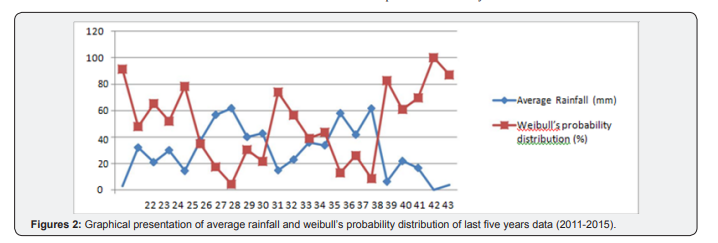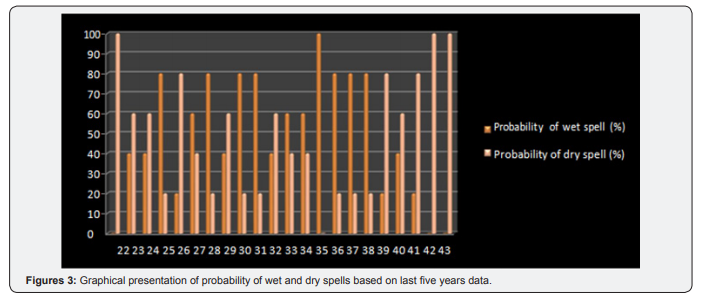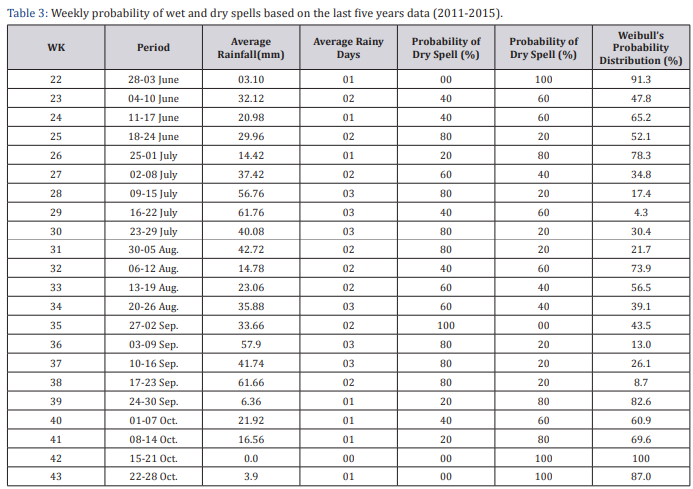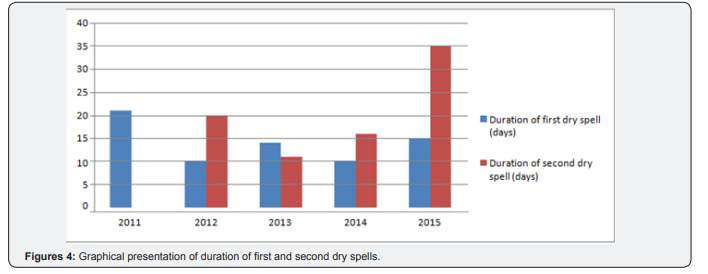Drought Analysis under Climatic Variability of Parbhani (2011-2015)
Pooran pragnya*, BW Bhuwibhar and Tapre Praveen Bake Nagraj
Department of Soil and Water Conservation Engineering College of Agricultural Engineering Technology, Parbhani, India
Submission: April 18, 2018; Published: April 27, 2018
*Corresponding author: > Pooran pragnya, Department of Soil and Water Conservation Engineering College of Agricultural Engineering Technology, Parbhani, India, Email: poornapragnya.joshi@gmail.com
How to cite this article: Pooran p, BW Bhuwibhar, Tapre P B N. Drought Analysis under Climatic Variability of Parbhani (2011-2015). Int J Environ Sci Nat Res. 2018; 10(4): 555792. DOI: 10.19080/IJESNR.2018.09.555792
Abstract
Climate is one of the most important driving parameter that causes year to year variability for short and long terms influences the water requirement, water availability and social water needs. Any change in climate will cause increase the uncertainty in water resource planning. Parbhani is intersected by 19008’ N latitude and 76050’ E longitude. The average annual rainfall at Parbhani station is 750-800mm, which is mostly received from south-west monsoon. The dates of onset and end of effective monsoon were determined for individual years by applying the criteria stated by Ashok Raj (1979) along with dry spell analysis. It was revealed that the average annual number of rainy days for Parbhani station was found out to be 38.The mean date of Onset of Monsoon was found to be 21st June and withdrawal of monsoon was 3rd October. Probability of 100% wet spell was found in 35th meteorological week (27 Aug-02 Sep) and probability of 100% dry spell was found in 42nd and 43rd standard meteorological week. First critical dry spell generally commenced in 30th week (2-3rd, August) with mean duration of 14 days. Second critical dry spell generally commenced in 40th week (4-5th, October) with mean duration of 21 days. Total 152 days of dry spell occurred in last five years with mean of 30 days per year.
Keywords: Climate change; desertification; ARIMA model; Regression; F value
Introduction
Climate change has been a topic of interest to many researchers with multiple areas of expertise. One of the most important necessities of research into climate change is to analyze and detect historical changes in the climatic system Cannarozzo [1]. Water availability is an important limiting factor for biological activities, and small variations in the amount, frequency, and intensity of water availability may have important consequences for the dynamics of human/natural systems Ceballos-Barbancho [2]. Changes in precipitation directly affect water resource management, agriculture, hydrology, natural ecosystems, and human health. For this reason it is important to investigate the changes in the spatial and temporal rainfall pattern to improve water management strategies. Dry spells affect not only in agriculture but also other sectors such as fisheries, health, electricity etc. Long dry spells may physically weaken the people which could cause mental degradation due to the lowering of their status. Therefore, the effects of dry spells in various sectors as described above ultimately has a direct impact on the economy of a country The information on the length of dry spells could be used for deciding a particular crop or variety in a given location, and for breeding varieties of various maturity durations. Information on dry-spell lengths could be used in decision making with respect to supplementary irrigation and field operations in agriculture. Prior knowledge of dry spell studies can be applied to generate synthetic sequences of rainfall and to the estimation of the irrigation water demand. The timing of breaks in rainfall (dry spells) relative to the cropping calendar rather than total seasonal rainfall is fundamental to crop viability. The longest period of sever along spells is of crucial importance in planning agricultural activities and managing the associated water supply systems.
The important characteristics of rainfall influencing production from agriculture in rain fed farming are the date’s onset of effective monsoon (OEM), the duration of rainy spells, dates of occurrence and duration of intervening dry and distribution of the rainfall during crop growing period. The occurrence of certain amounts of rainfall at crucial times can determine the successes of failure of crop. Duration of wet and dry spell helps to identify the duration of stress period Biswas [3]. Keeping these points in view, a special problem was undertaken with the following objective: To find out the probable dates of onset and withdrawal of effective monsoon along with dates and durations of critical dry spells occurred during last five years in Parbhani [4].
Materials and Method
Features of Study Area
The area is located in semi arid region of Maharashtra state. Parbhani is intersected by 19008’ N latitude and 76050’ E longitude. It comes under moderate rainfall zone at an altitude of 409m above mean sea level. The average annual rainfall at Parbhani station is 750-800mm, which is mostly received from south-west monsoon. Monsoon is generally concentrated over the months of June to September. The average annual air temperature is about 25.950C and the coldest and warmest monthly temperatures are 9.50C and 420C in December and May respectively [5].
Data Collection and Analysis
The methodology consists of collection of long term daily weather data such in respect of rainfall (mm) and other meteorological parameters. The daily rainfall data during 20112015 was collected from meteorology department, Parbhani and analyzed on annual basis. The daily rainfall data collected from meteorological department was concise to annual basis from 2011-2015 along with deviation. The number of rainy days was also calculated yearly and was presented graphically [6,7].
Onset of Effective Man Soon (OEM)
Pre-man soon rains cannot be considered as effective mansion for agriculture operations, particularly because these rains are followed by long dry spell which may affect the germination of seed resulting in crop failure if sowing is undertaken immediately after these showers. To identify 'effective monsoon ' as 'commencement of sowing rains distinct from pre monsoon showers', criteria suggested by Ashok Raj [4] was followed to determine onset of effective monsoon at Parbhani district. As per concept developed by on OEM and dry spell, effective monsoon is that monsoon which leaves enough moisture to supports agriculture operations. If the average daily evaporation is 'e' mm and after a prolonged dry spell, if it rains on a particular day an amount of 'r' mm of rain, it is assumed that only (r-e) mm of rain will be available for the soil that day. If it rains on the subsequent days, the evaporation loss will be less than 'e' mm. Rainfall of seven day satisfying evaporation demand is designated as the effective monsoon. Accordingly the data of commencement of a 7 days spell satisfying the Following criteria was defined as the data of onset of effective monsoon [8].
a) The first day rain in the seven days spell should be more than the average daily evaporation (e) of the place.
b) The total rain during the seven days spell should not be less than (5e+10) mm.
c) At least four out of these seven days should be rainy days with not less than 2.5 mm. a day is called a rainy days if the rainfall of that day is more than or equal to 2.5 mm.
The dates of onset of effective monsoon during each year for locations during each year for locations under study were determined by applying the criteria. After identifying the date of On set of effective monsoon xi (i =1, 2,3 n) in the Ith year for a particular rain gauge station, the mean date m is computed as follows :
M= xi/n (from i = 1 to n)
Where, n is the number of years.
Determination of Dry Spell and Wet Spell
The dry spells were found out by applying the criteria stated by Ashok Raj [4]. The interval between the end of 7 days spell, beginning with the onset of effective monsoon and another rainy days with 5 'e' mm or more of rain or the commencement of another 7 day rainy spell satisfying the criteria with a total rainfall of 5 'e' mm or more during this spell is called as the first dry spell similarly other dry spells are found. The interval between the OEM and the beginning of first critical dry spell is called the first wet spell. The subsequent wet spells are defined as the interval between two critical dry spell, thus the wet spells are spells of prolonged rain with possible intervening dry spells of duration less than the value depending on crop- soil complex of the region, which makes the dry spell critical.
Critical Dry Spell
If the duration of the dry spell occurred during the monsoon season exceeds a certain period depending on the crop soil complex of the region, the dry spell is called the first dry spell. Duration of 10 days was considered to classify the dry spell as critical during this study. There occurs more than one critical dry spell during every year. The critical dry spells were obtained for every year for Parbhani station. The mean dates of starting of critical dry spells were obtained by the same procedure adopted for obtaining the mean dates of OEM.
Probability Analysis

Weibull's Probability Distribution (%)
Average weekly rainfall was used to calculate Weibull's probability distribution. Average weekly rainfall was arranged in descending order later they were assigned with a rank. The largest value was assigned with Rank1 and so on then probability distribution was calculated using the following formula.
M is an assigned rank to that particular number; N is a no of observations.
Result and Discussion
Record of daily rainfall data for 5 years for Parbhani station was obtained from the Department of Agricultural Meteorology, VNMKV, and Parbhani. Data were analyzed to determine rainfall characteristics influencing agricultural operations and irrigation management. The characteristics include mean monthly rainfall, average weekly rainfall (AWR) and average annual rainfall. All other meteorological parameters such as maximum temperature, minimum temperature, wind speed, morning relative humidity, evening relative humidity, evaporation, and bright sunshine hours of each day from 2011-2015 were collected. These parameters were analysed on monthly basis to study the climatic variability. Daily rainfall and evaporation data of 5 years were used for determining the dates of onset and withdrawal of effective monsoon along with the duration of effective monsoon (Table 1). These determined dates were used to predict the critical dry spells and their length of occurrence.
Table 1 indicates that the average monsoonal rainfall of Parbhani is 757.6 mm but actual rainfall varied from 398.1 mm to 1017.1 mm. The average monsoonal rainfall of Parbhani from 2011-2015 was found to be 613.81mm with the average Deviation of -143.8mm (19%).

Drought Analysis
Onset and Withdrawal of Effective Monsoon: The rainfall data of 5 years (2011-2015) was taken in account. Daily rainfall and evaporation data of 5 years for Parbhani station from 2011 -2015 were analyzed to find out the dates of onset of effective monsoon and dates of withdrawal of monsoon during individual year (Table 2).


Table 2 Indicates that different dates for onset and withdrawal of effective monsoon in last five years. From above table it can be concluded that on and average monsoon onset's on 21st June and withdrawals on 2nd-3rd October with average duration of 104 days (Figure 1).
Weekly Probability of Dry Spells and Wet Spells
The five years daily rainfall data was converted into weekly basis. Average weekly rainfall, average weekly rainy days and probability of wet spells and dry spells were calculated based on standard criteria's and are presented in below Weibull's formula was used to calculate the probability distribution.
Critical Dry Spells
When the duration of dry spell exceeds a certain value depending on crop- soil complex of the region, it is called as critical dry spell. The critical value of duration of dry spell for Parbhani station was considered as 10 days. It is represented in (Table 3) and (Figures 2 & 3) show the critical dry spells occurred in Parbhani in last five years. In 2011, first critical dry spell occurred for 21 days which was more prolonged when compared to all other years.



Second critical dry spell was more prolonged in 2015, which occurred for 35 days. From above table it can be concluded that first dry spell generally occurred during 11-12th August with an average duration of 14 days and second dry spells occurred Critical dry spells occurred in last five years and their duration around 5th or 6th October and lasted with an average duration of 21 days. On an average 2 critical dry spells occurred in a year with 30 days annually (Table 4) and (Figure 4).


Summary and Conclusion
Climate is one of the most important driving parameter that causes year to year variability for short and long terms influences the water requirement, water availability and social water needs. Any change in climate will cause increase the uncertainty in water resource planning. Therefore, the analysis of hydro- climatic variables becomes an important task to understand the climatic variability and temporal changes. The dates of onset and end of effective monsoon were determined for individual years by applying the criteria stated by Ashok Raj. Mean dates of OEM and end of monsoon with standard deviation was determined for Parbhani station. Dry spell analysis was done by applying criteria stated by Ashok Raj and also critical dry spells were found during 2011 to 2015. Mean dates of critical dry spell along with their mean durations were also determined.
Following are the specific conclusions of the study:
a) The average annual number of rainy days for Parbhani station was found out to be 38.
b) The mean date of Onset of Monsoon was found to be 21st June and withdrawal of monsoon was 3rd October.
c) Probability of 100% wet spell was found in 35th meteorological week (27 Aug-02 Sep) and probability of 100% dry spell was found in 42nd and 43rd standard meteorological week.
d) First critical dry spell generally commenced in 30th week (2-3rd, August) with mean duration of 14 days.
e) Second critical dry spell generally commenced in 40th week (4-5th, October) with mean duration of 21 days.
f) Total 152 days of dry spell occurred in last five years with mean of 30 days per year.
References
- Cannarozzo MLV, Noto, F Viola (2006) Spatial distribution of rainfall trends in Sicily (1921-2000). Physics and Chemistry of the Earth 31(18): 1201-1211.
- Ceballos Barbancho A, E Moran Tejeda, MA Luengo Ugidos, JM Llorente Pinto (2008) Water resources and environmental change in a Mediterranean environment: the south-west sector of the Duero river basin (Spain). Journal of Hydrology 351(2): 126-138.
- Biswas BG, SD Maskel (1981) Rainfall analysis for use in Dry land Agriculture. Indian J Soil Conservation 9(2): 8-19.
- Ashok Raj PC (1979) Onset of effective monsoon and critical dry spells. A computer based forecasting technique: IARI Bulletin, New Delhi, India.
- Abdulmalek A, Al Asheikh, Qassem Y, Tarawneh (2013) An Analysis of Dry Spells Patterns Intensity and Duration in Saudi Arabia. Middle- East Journal of Scientific Research 13(3): 314-327.
- Kingra PK, KK Gill, Sompal Singh (2013) Wet and Dry Spell Analysis for Crop Planning in Sub-Mountainous Punjab using Markov Chain Approach. Journal of Agricultural Physics 13(2): 193-202.
- Mathugama SC, TSG Peiris (2011) Critical Evaluation of Dry Spell Research. International Journal of Basic & Applied Sciences 11(6): 153-160.
- Nityanand Singh, Ashwini A, Ranade (2009) Climatic and Hydro climatic Features of Wet and Dry Spells and their Extremes across India. Research Report No. RR-122. Indian Institute of Tropical Meteorology, Bulletin.






